




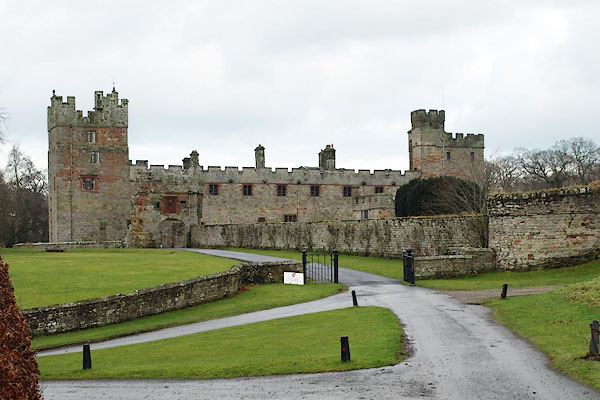
BPX50.jpg (taken 16.1.2009)
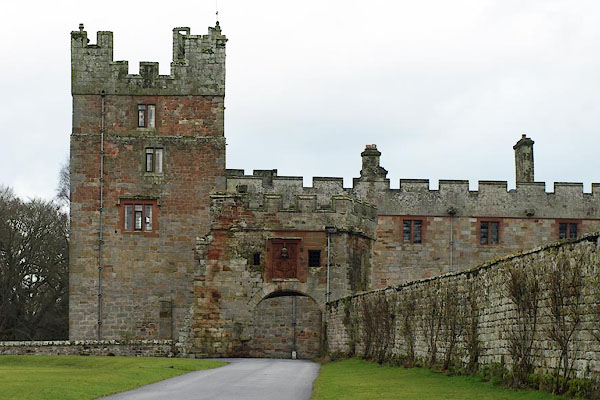
BPX51.jpg (taken 16.1.2009)
placename:- Naworth Castle

Sax9NY56.jpg
Building with two towers, symbol for a castle. "Naworth cast:"
item:- private collection : 2
Image © see bottom of page
placename:- Naworth Castle
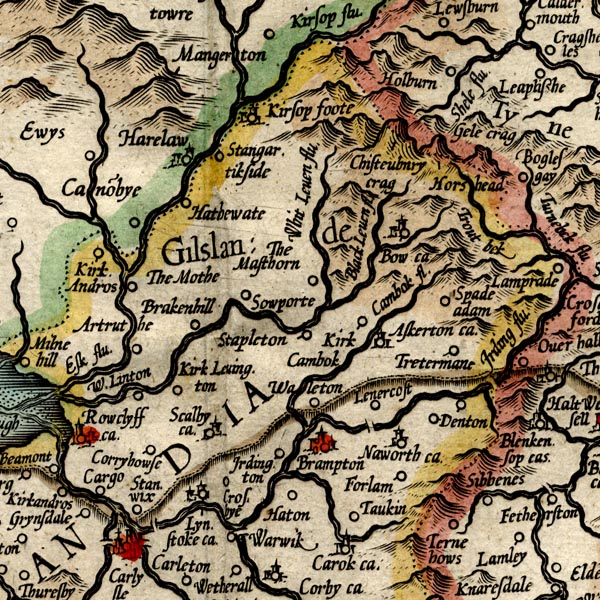
MER8CumA.jpg
"Naworth ca."
circle
item:- JandMN : 169
Image © see bottom of page
placename:- Naworth Castle
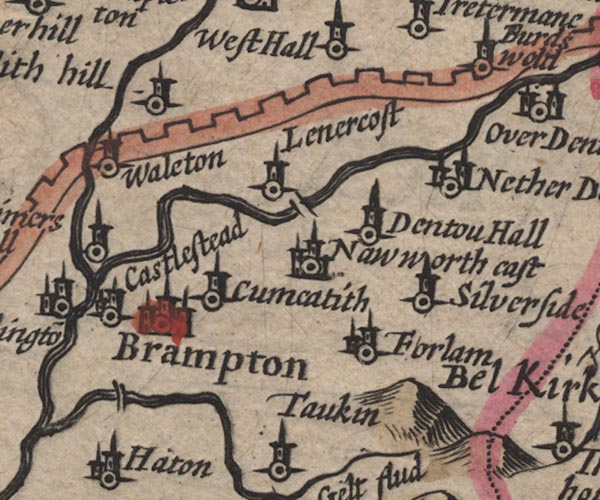
SP11NY56.jpg
"Naworth cast"
circle, building, tower
item:- private collection : 16
Image © see bottom of page
placename:- Naworth
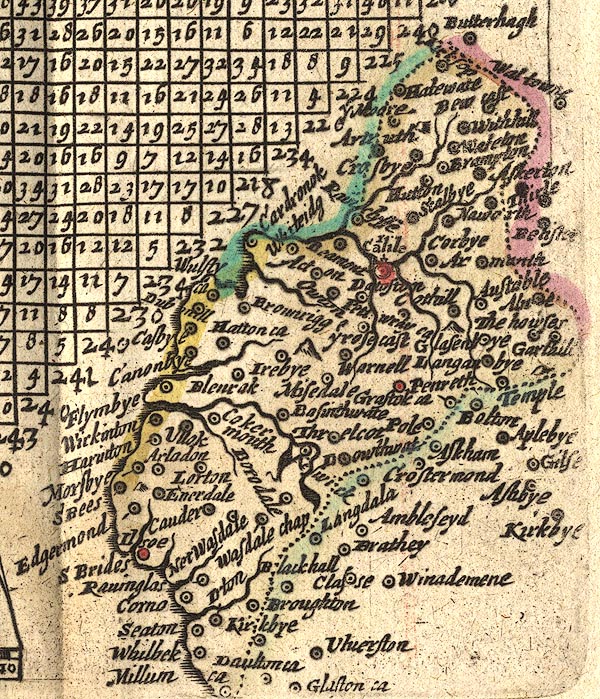
JEN4Sq.jpg
"Naworth"
circle
placename:- Naworth Castle
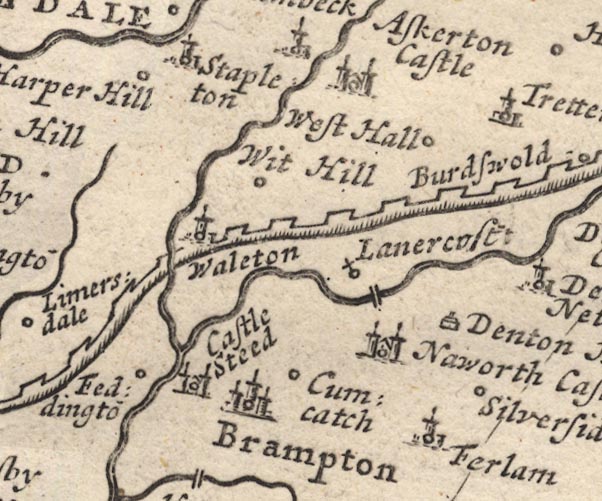
MD12NY56.jpg
"Naworth Castle"
Circle, building with two towers.
item:- JandMN : 90
Image © see bottom of page
placename:- Naworth Castle
item:- licence to crenellate; accident; wooden horse
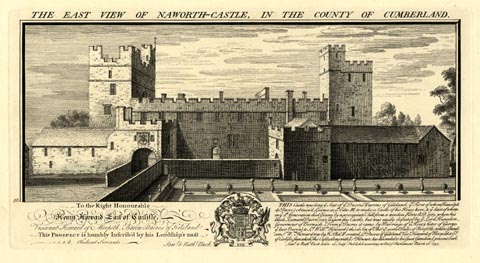 click to enlarge
click to enlargeBU0213.jpg
printed, top "THE EAST VIEW OF NAWORTH-CASTLE, IN THE COUNTY OF CUMBERLAND."
printed, bottom "THIS Castle was long ye Seat of ye Dacres Barons of Gilsland, ye First of whom (Ranulph de Dacre) obtain'd Licence in 9th. Edw. III. to make a Castle of his House here, & ye last of whom in ye 11th. Generation died Young by a precipitate Fall from a wooden Horse A.D.1569, when his Uncle Leonard Dacre seiz'd upon this Castle, but was easily defeated by ye Lord Hunsdon. Governor of Berwick. From ye Dacres it came by Marriage of ye Heir (Sister of George ye last Baron) to Ld. Willm. Howard (third Son of Thos. ye second Duke of Norfolk) whose Grandson Sr. Wm. Howard was by K. Chas. II. created Ld. Dacres of Gilsland, Visct. Howard of Morpeth & El. of Carlisle, from whom This Castle, along with ye sd. Honours, has descended to his Great Grandson ye present Earl. / Saml &Nathl. Buck delin: et Sculp: Publish'd according to Act of Parliamt. March 26. 1739."
item:- Armitt Library : 1959.67.13
Image © see bottom of page
item:- roman inscription; inscription, roman
 goto source
goto sourceGentleman's Magazine 1746 p.537 "... ..."
"Mr. URBAN,"
"I Send you herewith an inscription on a stone in the South East wall of Naworth garden, unpublish'd."
 click to enlarge
click to enlargeG746E02.jpg
 goto source
goto sourceGentleman's Magazine 1746 p.538 "..."
"The little stone is the greatest rarity, and being situated behind a bush escaped observation. I read it PEDITUM CENTUM QUINQUAGINTA BRITANNORUM. We never knew before this that the Romans indulg'd any national troops the favour of garrisoning their own territories; but here are 150 BRITISH foot assign'd to that use; whether that was at Burd-Oswald, or elsewhere appears not, because we are not postively sure whence some of these stones at Naworth came; many of them are certainly from Burd-Oswald, but to affirm all are so, wou'd be taking too much upon me, till future discoveries explain the matter."
"For the sake of the lovers of antiquity, I take pains to rake into these ruins, and shall be pleased if any service might thence ensue to the commonwealth of learning."
"Yours &c."
"GEO, SMITH."
"Aug. 25, 1746."
item:- rebellion, 1745; 1745 Rebellion
 goto source
goto sourceGentleman's Magazine 1746 p.233 "... [1745 Rebellion]"
"On Monday the 11th [11.11.1745] the prince's lifeguards, as they were called, came to Naworth Castle the earl of Carlisle's seat, and I went to see them, they behaved in general with much complaisance and were well-dress'd, good-looking men: ..."
"The same morning [12.11.1745] capt. Hamilton, quarter-master general of the foot, came to Naworth, demanding billets for 6000 men: the guards look'd very blank at the proposal, and began to secure their portables, and I soon found what a nest of thieves we were going to have."
"About noon several hundreds of a wretched, ill-looking, shabby crew pass'd by armed with targets, broad swords, muskets, &c. and seemed very angry if no deference was paid to their flag: that afternoon and all next day they spent in shooting sheep, geese, &c. and robbing on the highway: tho' their chiefs express'd great dissatisfaction at their proceedings, yet they dar'd not restrain them for fear of putting them out of humour. Betwixt that and the 16th, I had some of their hussars, an audacious, insolent, lying rabble, and on Saturday the 16th six of the officers of the M'Phersons, who were by far the civilest of their foot, and pay'd for what they had in a genteel manner enough; ..."
placename:- Naworth Castle
 goto source
goto source"... Naworth Castle, the Sea[t] of the Right Honourable Henry Howard, Earl of Carlisle. ..."
placename:- Naworth Castle
placename:- Naward Castle
item:- library, Naworth; Saxon kings; St Joseph of Arimathea, Life of; Glastonbury Abbey, Somerset; hagiography; indulgences; hanging; chapel, Naworth
 goto source
goto sourcePennant's Tour 1773, page 172 "Naworth or Naward-castle, the usual residence of the"
 goto source
goto sourcePennant's Tour 1773, page 173 "barons of Gillesland, stands about two miles east of Brampton. It is a large pile, square, and built about a court, with a square tower at each corner. In the south side is a gateway with the arms of the Dacres; over the door those of the Howards. On the north, it impends over the river Irthing, at a great height; the banks shagged with wood. The whole house is a true specimen of ancient inconvenience, of magnificence and littleness: the rooms numerous, accessible by sixteen stair-cases, with most frequent sudden ascents and descents into the bargain; besides a long narrow gallery. The great hall is twenty-five paces long, by nine and a half broad, of good height; has a gallery at one end, adorned with four vast crests, carved in wood, viz. a griffin and dolphin with the scallops, an unicorn, and an ox with a coronet round his neck. In front is a figure, in wood, of an armed man; two others, perhaps vassals, in short jackets and caps, a pouch pendant behind, and the mutilated remains of Priapus to each; one has wooden shoes. These seem the ludibrium aulae in those gross days."
"The top and upper end of the hall is painted on panels, in squares, to the number of one hundred and seven, representing the Saxon kings and heroes; these are said to have been brought from Kirk-Oswald Castle. The chim-"
 goto source
goto sourcePennant's Tour 1773, page 174 "[chim]ney here is five yards and a half broad. Within this is another apartment, hung with old tapestry: a head of Anne of Cleeves; on one side of her, a small picture of a Lady full length, &c. and many others."
"Lord William Howard's's bed-room - arms and motto over the chimney. His library is a small room, in a very secret place high up in one of the towers, well secured by doors and narrow staircase. Not a book has been added since his days, i.e. those of Queen Elizabeth. In it is a vast case, three feet high, which opens into three leaves, having six great pages pasted in, being an account of Saint Joseph of Arimathea, and his twelve disciples, who founded Glastonbury; and, at the end, a long history of Saints, with the number of years or days for which each could grant indulgences."
"The roof is coarsely carved. The windows are high, and are to be ascended by three stone steps, lest the inhabitant should be reached by some arrow or shot from without; such was the caution of those times. It is said, Lord William was very studious, and wrote much: that once, when he was thus employed, a servant came to tell him that a prisoner was just then brought in, and desired to know what should be done with him. Lord William"
 goto source
goto sourcePennant's Tour 1773, page 175 "vexed at being disturbed, answered peevishly, "Hang him!" When he had finished his study, he ordered the man to be brought before him for examination, but found that his orders had been literally obeyed. He was a very severe, but a most useful man at that time in this lawless country. His dungeon instils horror; it consists of four dark apartments, three below, and one above up a long staircase, all well secured; in the uppermost is one ring, to which criminals were chained, and the marks where many more have been."
"Close by the library is an ancient oratory, most richly ornamented, on the sides of the cieling (sic), with coats of arms, and carvings in wood painted and gilt. On one side is a good painting on wood, in the style of Lucas Van Leyden; it represents the flagellation of our Saviour, his crucifixion, and resurrection. Here are also various sculptures in white marble: an Abbess with a sword in her hand, waiting on a King who is stabbing himself; a Monk with a King's head in his hand; and several others. This place is well secured; for, here, Lord William enjoyed his religion, which he did not dare avow, in privacy."
"The chapel is below stairs; the top, and part of the side,"
 goto source
goto sourcePennant's Tour 1773, page 176 "are painted in pannels, like the hall; and on one side are the crests, arms and pedigree of the Howards, from Fulcho to 1623 and 1644. On the cieling, beneath the great sprawling figure of an old man, with a branch issuing from him representing the Root of Jesse, is written, "Pictor, MDXII." On the great window, in glass, are represented a Knight and a Lady kneeling - Thomas lord Dacre, who died in 1525, and his Lady Elizabeth, the rich heiress of the barony of Greystoke: on his tabard, the arms of Dacre quartering Vaux; on her mantle the same, and on her kirtle Greystoke-ancient quartering Grimethorpe or Greystoke-modern."
"The time in which this castle was founded, is very uncertain. It is supposed to have been by a Dacre. The first mention of it is in 1398, when it was held by a William de Dacre. In January 1569-70, it was, as I have already mentioned, for a short time seized and possessed, together with other estates of the family, by Leonard Dacre of Horsely in Yorkshire, second son of Lord William Dacre."
"The several ancient inscriptions on stones taken from the neighbouring wall, have long since been removed to Rokeby in Yorkshire, the seat of the late Sir Thomas Ro-"
 goto source
goto sourcePennant's Tour 1773, page 177 "[Ro]binson. This castle is the property of the Earl of Carlisle, derived from his ancestor Lord William Howard."
placename:- Naward Castle
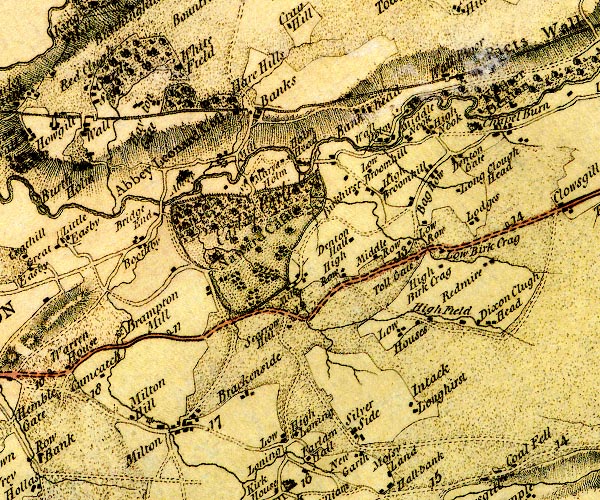
D4NY56SE.jpg
"Naward Castle / Earl of Carlisle"
large building; a castle and double outline with suggested fence palings; a park
item:- Carlisle Library : Map 2
Image © Carlisle Library
placename:- Naworth Castle
 goto source
goto sourcePage 105:- "..."
"I do not find any ancient authors mention a castle here [Castlerigg], Speed, who speaks of twenty-five in Cumberland, hath found out every one I ever heard or knew of, except Kirkoswald; how that has escaped him I cannot tell. I shall here put down their names, and, as well as I can, their most ancient owners, and supposed founders."
"..."
 goto source
goto sourcePage 106:- "..."
"4. NAWORTH. Built by Hubert de Vallibus, and repaired by Ranulph de Dacre, now the Earl of Carlisle's."
"..."
placename:- Naward Castle
 goto source
goto sourcePage 190:- "..."
"... The hall [Kirkoswald Castle] I have seen 100 yards long, and the great pourtraiture of king Brute, lying in the end of the roof of this hall, and of all his succeeding successors, kings of England, portraieted to the waist, their visages, hats, feathers, garbs, and habits, in the roof of this hall; now translated to Naward"
 goto source
goto sourcePage 191:- "castle, where they are placed in the roof of the hall, and at the head thereof, where many of them still remain. ..."
placename:- Naworth Castle
item:- coat of arms; portraits, Kings of England; Kings of England, portraits; tapestry; Glastonbury Abbey; hanging; genealogical tree; library; painting; sculpture; roman inscription; inscription, roman; gate post; museum, Rookby; Rookby
 goto source
goto sourcePage 204:- "..."
"Naworth, "a fair castle called the lord Davers," is still intire and inhabited, though not by the earl of Carlisle, whose property it is. It is large, and built round a square court, overhanging the river Irthing at a great height, with towers at each corner. Over the south gate and door are the arms of the Dacres and Howards. The rooms are numerous, ascended to by 16 staircases, the great hall 25 paces long by nine and a half, with a gallery at one end. The top and upper end painted on wood in squares with Saxon kings and heroes brought from Kirk Oswald castle, when it was demolished. Within this is another room hung with tapestry, with portraits of Anne of Cleves and the family. Lord William Howard's bed-room has his arms and motto over the chimney. His library is a small room in a very secret place high up in one of the towers well secured by doors and narrow staircases; not a book added since his time. In it is a vast case, three feet high, opening into three leaves, on which are pasted in six great pages an account of the foundation of Glastonbury abbey by Joseph of Arimathea, and a long history of saints with their indulgences. The roof is coarsely carved, the windows high, ascended by three stone steps. It is said lord William was very studious, and wrote much; and that once when he was thus employed, a servant announced the arrival of a prisoner, and asking what was to be done with him, his master, vexed at the interruption, peevishly bid him hang him, which order he wished to have recalled when he found it was executed. He constantly kept a garrison of 140 men here, and his severity was of great importance in this lawless tract. his dungeon consists of three dark apartments below, and one above up a long staircase all well secured. In the upper a ring to which criminals were chained, and the marks of many more. The gallery is 150 feet long. Close by the library is an antient oratory well secured, the cieling richly ornamented with coats of arms and carving painted and gilt. On one side a good painting on wood of the style of Lucas van Leyden, of the Scourging, Crucifixion, and Resurrection of Christ; also various sculptures in white marble. Here his lordship enjoyed his religion in privacy. The chapel is below stairs, the top and part of the sides painted in pannels like the hall, and with the crests and arms of the family to 1623 and 1644. On the ceiling a man with a genealogical tree, and under him Pictor MCXII. In the east window a knight and lady, with three escallops and chequè on their mantles. This castle is first mentioned 18 Richard II. It continued in the Dacres till the death of lord George 1569, whose sister married lord William Howard. It was again repaired by Charles Howard earl of Carlisle, who left the library in good order. The MSS. were enumerated in the Cat. Manuscriptorum Ang. &Hib. tom.II. p.14. chiefly relating to heraldry and English history, but not above one or two are now here. In the garden walls was fixed a collection of Roman inscriptions from the neighbourhood (this being the greatest receptacle in this county except that at Elenborough hall), which, when Dr. Stukeley was here, were neglected, and some even cut up to make gateposts. The remainder were given by the late earl to sir Thomas Robinson, and are now neglected and abused in the museum at Rookby, the seat of Bacon Morrit, esq. Among these are Horsley's Cumb. viii. ix. x. lviii. Others first published by Horsley, and not traceable since his time, when they were all much neglected, are Cumb. xii. xiii. xiv. xv. p.255. and an altar cut through the middle for a gate post, which never had an inscription. Bishop Gibson has copied Horsley's viii. ix. at Naworth, though Camden had given it at Burdoswald. Horsley takes no notice of the other two which he gives. We have copied from Horsley those in Pl.XIV. fig.2, 3, 4, 5, 6, 7, 8."
placename:- Naworth Castle
 goto source
goto sourcePage 176:- "..."
"... Naworth castle, now belonging to William Howard before-mentioned, who is repairing it, lately the barons Dacre, the last of whom dying a few years ago under age, his uncle Leonard who chose rather to carry on a war with his sovereign than a suit about the estate with his nieces, seized this castle, and levied a body of rebels against his prince, which lord"
 goto source
goto sourcePage 177:- "Hunsdon, the warden, with the garrison of Berwic, easily dispered with great slaughter and disorder, Leonard himself escaping by flight. This last circumstance proved the security of their chief. ..."
placename:- Naworth Castle
 goto source
goto source click to enlarge
click to enlargeC38321.jpg
page 321-322 "2 Miles on r. of Brampton is Naworth Castle, Earl of Carlisle."
item:- JandMN : 228.1
Image © see bottom of page
placename:- Naworth Castle
 goto source
goto source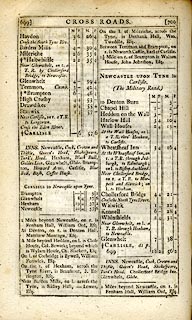 click to enlarge
click to enlargeC38699.jpg
page 699-700 "Between Temmon and Brampton, on r. is Naworth Castle, Earl of Carlisle."
item:- JandMN : 228.2
Image © see bottom of page
placename:- Neward Castle
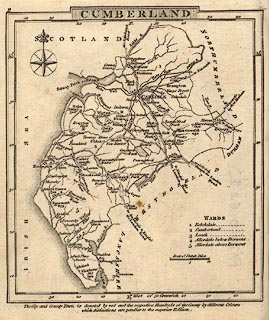 click to enlarge
click to enlargeGRA1Cd.jpg
"Neward [Cas]"
item:- Hampshire Museums : FA2000.62.2
Image © see bottom of page
placename:- Naward Castle
item:- inscription, roman; roman inscription
 goto source
goto source"... Two miles distant [from Brampton] stands Naward castle, the seat of the earls of Carlisle. There are several good paintings in it, brought from Kirkoswald castle when the latter was demolished. It was built in the reign of Henry III. and in the walls of the garden were stones with various Roman inscriptions; but they have been removed to sir Thomas Robinson's museum at Rooksby. ..."
placename:- Naworth Castle
item:- siege, Carlisle; Battle of Towton Field; wars of the Roses; library, Naworth Castle; England, Kings of
Descriptive text:- "NAWORTH CASTLE is the seat of the Barony of Gilsland. This barony was given, in the reign of William the Conqueror, by Ralph de Meschines to Hubert, who assumed the name of De Vallibus or Vaux; his immediate posterity were of much distinction among the baronial families of the North; Robert, his son, was sheriff of Cumberland, and defended the city of Carlisle, during a long siege, against William King of Scotland, but was obliged, at length, to surrender it for want of provisions; Robert, the grandson of this Robert, was one of the barons in arms against King John. The sole heiress of Hubert de Vaux, son of the last mentioned Robert, brought the barony of Gilsland to Thomas de Multon, in the reign of Henry III. The grandson of this Thomas died in 1313, leaving an only daughter, Margaret, who was forcibly carried away from Warwick Castle, in the year 1317, by Ralph Dacre, she being then under age and the King's ward; she was 13 years of age at the time of her father's death. This Ralph Lord Dacre had a license, in the year 1335, to castellate his mansion of Naworth; his descendant, Ralph Lord Dacre, of Gilsland, was slain at Towton-field, fighting on the side of the House of Lancaster; Naworth and all his estates were seized by the victorious monarch, but restored to his son: Thomas Lord Dacre, grandson of Ralph, distinguished himself at Flodden-field. By the untimely death of George Lord Dacre (great-grandson of Thomas last mentioned,) which happened in his minority in the year 1569, the great inheritance of his family was divided between his three sisters and coheiresses, and the barony of Gilsland fell to the lot of Elizabeth, who married Lord William Howard, third son of Thomas Duke of Norfolk. Leonard Dacre, the next male heir in the family, (second son of William Lord Dacre, who died in 1565,) being discontented at the inheritance of his family going to females, and having no hope of success in disputing it by law with his nieces, forcibly possessed himself of the castles of Naworth and Greystock, and fortified them, having collected together a force of 3,000 borderers and others; but having been defeated by Lord Hunsdon with the garrison from Berwick, near Gelt-bridge, he fled into Scotland and was soon after attainted. Lord William Howard's marriage took place in 1577; it appears to have been late in life that he settled at Naworth Castle, which Camden, who paid his last visit to Cumberland in company with Sir Robert Cotton in 1599, speaks of in his edition of 1607, as then repairing for his residence."
"Naworth Castle, which stands on the brink of a precipice, being almost inaccessible on three sides, is said to have been garrisoned by the Lord William Howard with 140 men. His own suite of private apartments in the eastern tower, barricadoed with iron doors, are still to be seen with their original furniture. They consist of a bed room, oratory, and library; many books belonging to the latter have the autograph of the original possessor, written in a very fair hand. There was formerly a valuable collection of MSS. in this library. The hall is 70 feet in length, 24 in width, and of proportionable height; on the ceiling are imaginary portraits of the Kings of England, down to the Union of the Houses of York and Lancaster. In the chapel are kneeling figures of Thomas Lord Dacre, who died in 1525, and his lady, the heiress of Greystock. Opposite the pulpit are the arms and pedigree of the Howards, Dacres, &c. The dungeons of the castle still remain in their original state, consisting of four small apartments, three below and one above; in the latter is still a ring, to which criminals were chained. These no doubt were the ancient prisons of the barony, the court of which had the power of life and death: it appears on record, that beheading was the punishment of felons."
"Sir Charles Howard, great grandson of Lord William, was in 1661 created Earl of Carlisle. Bishop Gibson tells us that Naworth Castle, which had been some time in a neglected state, was fitted up by Charles, the third Earl of Carlisle: this Castle is occasionally inhabited by the present Earl."
item:- Armitt Library : A6666.22
Image © see bottom of page
item:- Border Wars
 goto source
goto sourceGentleman's Magazine 1819 part 1 p.506
From the Compendium of County History:- "1569. At Naworth, December, the insurgent Earls of Northumberland and Westmorland disbanded their forces."
"1570. From Naworth castle, Leonard Dacre, claiming the baronies of Gilsland and Greystock, sallying out to attack Lord Hunsdon, was defeated and compelled to fly to Scotland."
item:- Life of King Arthur; Legend of Joseph of Arimathea; Arthurian legend
 goto source
goto sourceGentleman's Magazine 1834 part 1 p.176 "..."
"It has been said, that at the dissolution of the monasteries in England, several articles belonging to Glastonbury Abbey were transferred to Naworth Castle, in Cumberland, then in the possession of Lord William Howard, the friend of Camden, who seems to have believed in the monkish fable and in the cross with Arthur's name, which he has given in the Britannia."
"Mr. Ritson, in his Life of King Arthur, p.139, states that there is still preserved at the above-mentioned castle a huge volume of three vellum leaves, standing on the floor, being the original legend of Joseph of Arimathea, which Leland beheld with admiration on his vist to Glastonbury Abbey. It would be very desirable to know whether this volume still exists, and to have a particular account of it, as well as of any articles formerly in Glastonbury. A catalogue too of the ancient library at Naworth Castle, if it could be obtained by permission of the noble owner, would also be a most acceptable present to many a bibliomaniac of the present day."
placename:- Naworth Castle
 goto source
goto sourcePage 112:- "..."
"NAWORTH CASTLE."
"Here, however, we should recommend the carriage to be sent up to the Castle, while the stranger pursues the banks of the Irthing by a footpath which leads to the right from the river up a deep ravine, whose steep sides wave with aged woods. The oaks are splendid, and the grey turrets and battlements of the Castle, seen in combination with them, impress the mind with feelings of solemn grandeur."
"A short distance in front of the keep is a circular bastion or barbican. The keep stands a little in advance of the main body of the Castle, and over the archway are carved in bold relief the armorial bearings of the family. The Castle forms a complete quadrangle, the front being an extended curtain, battlemented, and connecting the two square and lofty towers at the angles. Having entered this through a small passage, you stand in the court-"
 goto source
goto sourcePage 113:- "[court]yard, and those who have visited Cambridge or Oxford will be struck with its resemblance to some of the college quadrangles. On one side a flight of steps leads to the long ancient hall, in which are a succession of portraits of the English kings, and some rude wooden armorial emblems brought from Kirkoswald Castle, besides figures clad in plate armour, one in that belonging to Lord William Howard. The chapel is in another angle; its ceiling is adorned with the genealogical tree of the Dacres and Howards. Both the hall and chapel are lighted with perpendicular windows, whose mullions are embattled. The state drawing-room and bed-room, with their tapestried walls and decaying furniture, show the poor comfort that the nobles of old times enjoyed, compared with what even poor people possess at present. The gallery is enriched with a few portraits, and several good specimens of ancient armour. But the chief objects of curiosity are the apartments of Lord William Howard, which are entered through a small door-way, strongly barred by a massy iron door, having the pannels filled with oak, and strengthened with a couple of bolts of corresponding dimensions. One person at a time only can enter; then the stair-case winds spirally up to the oratory and study, similarly protected, and thus rendering the access still more difficult. His bed is still preserved, but sadly tattered and torn by persons anxious to possess some memorial of Belted Will, the severe but salutary scourge of a race of bold, reckless, murderous"
 goto source
goto sourcePage 114:- "moss-troopers. His books, at least some of them, remain to show what his studies were in those intervals, which his important and busy and watchful situation as Lord Warden of the Marches allowed for such peaceful, soul-soothing pursuits. The ceiling is of massy oak, in plain intersecting pannels. The dungeons below are arched and without light; the rings still remain to which men, whose fierce untamed nature could not otherwise be subdued, or taught that there was neither honour nor glory in such wild raids and burnings, were chained and treated as the wild beasts of the forests. And the tourist will happily think how blessed he is, that his line has been thrown upon quiet waters and in such peaceful times, and under a constitution that both wills and enables every man to sit under his own vine, and eat with thankfulness the labour of his own hands. There are other apartments which are kept for the Earl of Carlisle and his family, whenever they visit this part of their possessions. The Castle is situated on the tongue of a precipice, surrounded on all sides by deep glens, except the front, from which the park extends up a gradually-rising ground, so that to the spectator approaching from Brampton it appears very low."
placename:- Naworth Castle
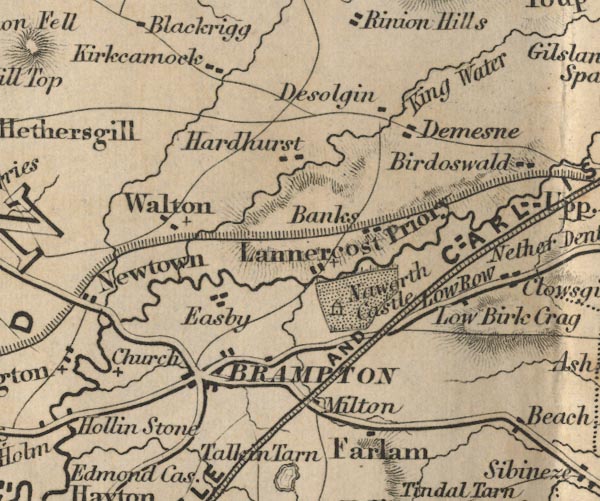
FD02NY56.jpg
"Naworth Castle"
Building and park.
item:- JandMN : 100.1
Image © see bottom of page
 goto source
goto sourceGentleman's Magazine 1839 part 2 p.510
From a review of A Guide to Naworth and Lanercost, by Samuel Jefferson. "..."
"Mr. Jefferson has presented us with the copy of a catalogue of the library. From the dates of some of the books, it appears to have been made some time subsequently to Lord William's day; though the greater number of them are the best historical and learned works that were published in his life-time. One volume, a Treatise on the Real Presence, contains the autograph of John Fisher, Episcopus Roffensis; another was a present from an Abbat (sic) of Fountains. On the title-page of most of the books is the autograph of Lord William Howard, written in a good hand, and, in some cases, a short remark is added. For instance, in a"
"*Lysons states that most of these MSS. are now in the library of the Heralds' College."
item:- Lines to a Jasmine Tree in the Court of Naworth Castle
 goto source
goto sourceGentleman's Magazine 1839 part 2 p.511 "book of Martin Luther's is written William Howarde. Volo sed non valeo (the family motto), non possum quod desidero. On a copy of Calvin's Institutes, 1569, is Qui sibi videtur stare videat ne cadat. On a copy of Galatea is, for thear glory is to change, and thear liberty is to rainge. On another volume is the softer language of conjugal affection, Merces amoris amor. Mary Howarde. W. Howarde. 1582."
"The three officers, the diary of whose tour in 1634 is preserved among the Lansdowne manuscripts, were hospitably entertained by Lord William Howard and his lady at Corby castle. The writer says -"
""These noble twain (as it pleas'd themselves to tell us themselves) could nott make above 25 yeares both togeather when first they were marry'd, that now can make above 140 yeares, and are very hearty well and merry, and long may they continue soe, for soe have they all just cause to pray, that live neere them; for their hospitality and fre entertainment agrees with their generous and noble extraction, and their yeares retains the memory of their honourable predecessor's bountifull housekeeping.""
"This little book includes a very interesting biography of Lord William Howard, for which the materials have been furnished in the elaborate and very magnificent volume, of Memorials of the Howard family, recently printed by Mr. Howard of Corby."
"The ancient MS. relative to the abbey of Glastonbury, described in the extract we have given respecting the library, is the same which was inquired after by the late Mr. Douce, in our Magazine, shortly before the publication of Warrer's History of Glastonbury. We are happy to find that it is still preserved."
"In p.37 we find mentioned four large carvings of wood, in the great hall, "representing a griffin, a unicorn, a dolphin, and a bull; these" it is added, "formed the crests of the Dacre, Multon, Greystock, and Grimthorp families, and have evidently been made to carry banners with the same arms." Gigantic carvings of this kind are seen over the gateways of several of the castles in the North, as at Hilton, and elsewhere. We notice the present description, to remark upon the inaccuracy of the term crests; they would more properly be called supporters. At the time of their execution they used to be called "beasts," and only one was used, which bore the arms on a banner, as mentioned in the present case. The ancient crests of these families, it will be found on inquiry, were something different: for all ancient crests are such as a knight might really carry on his head, not an entire animal, neither an elephant nor a castle, - though very frequently an animal's head."
"In p.39 we find mentioned the name of an old painter, who adorned the panels of the ceiling of the chapel with the heads of the genealogy of Christ, springing from the root of Jesse, in fifty-four compartments. It is given "Magister Lucas Egliement, Pictor MCXII." But we suspect there may be some trifling error. Can the artist be the same with Cornelius Engelbert, who, as noticed by Walpole in his Anecdotes of Paintings, came to England and was made painter to Henry the Eighth? The date appears full early for him; but in that also there may be some mistake."
"..."
item:- Lines to a Jasmine Tree in the Court of Naworth Castle
 goto source
goto sourceGentleman's Magazine 1839 part 2 p.511 "..."
"We have not time to accompany Mr. Jefferson to Lanercost abbey, though he appears to have described the ruins of its architecture in a very satisfactory manner; but we will now conclude with the following very elegant verses, by the present heir apparent of Naworth, who appears to inherit the poetical talents of his late grandfather, Frederick, Earl of Carlisle:"
"LINES TO A JASMINE TREE IN THE "COURT OF NAWORTH CASTLE,""
"Written by Viscount Morpeth."
"My slight and slender jasmine tree
That bloomest on my border tower,
Thou art more dearly loved by me
Than all the wreaths of fairy bower.
I ask not, while I near thee dwell,
Arabia's spice or Syria's rose;
Thy light festoons more freshly smell,
Thy virgin white more freshly glows."
 goto source
goto sourceGentleman's Magazine 1839 part 2 p.512 "My mild and winsome jasmine tree,
That climbest up the dark grey wall,
The tiny flowrets seem to glee
Like silver spray-drops down to fall;
Say, did they from their leaves thus peep
When mail'd moss-troopers rode the hill;
When helmed warders paced the keep,
and bugles blew for Belted Will?"
"My free and feathery jasmine tree,
Within the fragrance of thy breath
Yon dungeon grated to its key,
And the chain'd captive pined for death.
On border fray, on feudal crime,
I dream not while I gaze on thee;
The chieftans of that stern old time
Could ne'er have loved a jasmine tree."
item:- Guide to Naworth and Lanercost
 goto source
goto sourceGentleman's Magazine 1839 part 2 p.509
From a review of A Guide to Naworth and Lanercost, by Samuel Jefferson. "..."
"Naworth Castle, the chief residence of the Dacres lords of Gilsland, has been characterised by Sir Walter Scott as "one of those extensive baronial seats which marked the splendour of our ancient nobles, before they changed the hospitable magnificence of a life spent amongst numerous tenantry, for the uncertain honours of court attendance, and the equivocal rewards of ministerial favour." It was here that the celebrated Lord William Howard, better known as Bold or Belted Will Howard, a man"
"..."
item:- coat of arms
 goto source
goto sourceGentleman's Magazine 1839 part 2 p.510 "of superior talents, as well as extensive territory, passed a long life in the exercise of vice-regal power: and what renders the place particularly interesting, is the circumstance that, from the death of that distinguished personage in the year 1640, "This castle has undergone little alterations, either in respect of the buildings, furniture, ornaments, or appearance. It seems, like few fortresses of so much strength, to have escaped during the ensuing season of devastation and bloodshed, as no record exists to show that it was held either for the King or Parliament." (P.14.)"
"..."
"At the end of the picture gallery, a massive iron-grated door, secured with huge bolts, forms the entrance to the rooms which remain as Lord William Howard left them."
""After passing through a short dark passage, the first apartment is entered. It is a bedchamber, retaining its original furniture, measuring 14 feet by 18 feet; the floor is formed of a hard composition, and the mantlepiece has sculpted on it three shields, with the arms of Dacre quartering those of Vaux, Lancaster, and de Morville; Dacre impaling Greystock (modern); and Boteler of Wemme impaling ---, supposed to be Vaux. The shields are all surrounded by the garter, and on labels between them is the motto Fort en loialte. The walls are wainscoted with oak and covered with tapestry. On pushing aside a panel of the wainscot near the fire-place, there is a dark apartment vaulted with stone, and guarded at the entrance by a strong door of oak."
""Above the bedchamber and secret room are two other apartments, forming a library and a private chapel. A circular stone staircase, dark and narrow, admitting only one person to ascend at a time, conducts us to these rooms. The library is of the same size as the bedchamber beneath it, but more gloomy. It is fitted up with plain closets, filled with a valuable collection of old works on history, school-divinity, &c. There was formerly a good collection of MSS. in this library, but only a few of them now remain, and those of little value.*"
""There is, however, one extremely curious document, containing a life of Joseph of Arimathea ('extractus de libro quem invenit Theodosius imperator in Jerusalem') and his twelve disciples; together with a history of saints, with the number of years or days for which each could grant indulgences in the monastery of Glastonbury. It is written on six large skins of fine vellum, beautifully illuminated, and is pasted in a wooden case, with two folding leaves, the dimensions of which are two feet by three feet. There is an old reading desk of four sides, in the form of a pyramid, with a flattened apex; which, by means of a screw passing through the centre, can be raised or depressed at pleasure."
""The windows of this chamber are narrow, and are reached by an ascent of three steps. The ceiling is richly carved, in a similar manner to the ceiling in the deanery of Carlisle. The corbels and bosses are embellished with armorial devices. Here Lord William spent much of his time; 'a lover of the venerable antiquity,' as he was styled by Camden, having closed his door, he could pursue his favourite study without interruption.""
"..."
placename:- Naward
item:- licence to crenellate
 goto source
goto sourceGentleman's Magazine 1856 part 2 pp.323-330 "..."
"LICENCES TO CRENELLATE, FROM THE PATENT ROLLS IN THE TOWER OF LONDON."
"..."
"EDWARD III. A.D. 1327. Jan. 25. 1377. June 21."
"..."
"9. Ranulphus de Dacre mansum Nawardh ... Cumbr."
"h The celbrated Naworth Castle, - a portion of which is of this period."
placename:- Naward
item:- licence to crenellate
Licence to crenellate granted by Edward III; 27 Juy 1335:- "Ranulphus de Dacre ... mansum suum ... Naward, Cumberland."
placename:- Naworth Castle
item:- door; iron yett
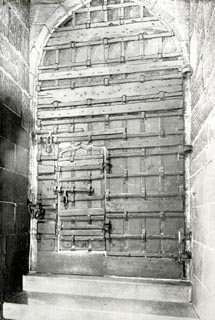 click to enlarge
click to enlargeCW0134.jpg
Tipped in opposite p.177 of The Castles and Fortified Towers of Cumberland, Westmorland, and Lancashire North of the Sands, by John F Curwen.
printed at bottom:- "NAWORTH CASTLE: GREAT PORTAL. / Photo. by Rev. G. J. Goodman. ..."
item:- Armitt Library : A782.34
Image © see bottom of page
placename:- Naworth Castle
item:- door; iron yett; lintel; Carnarvon arch; Dacre's Tower; arch
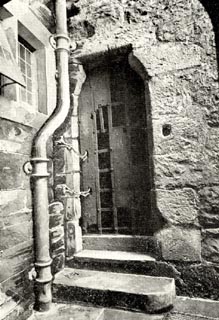 click to enlarge
click to enlargeCW0131.jpg
Tipped in opposite p.175 of The Castles and Fortified Towers of Cumberland, Westmorland, and Lancashire North of the Sands, by John F Curwen.
printed at bottom:- "NAWORTH CASTLE: DOORWAY TO DACRE'S TOWER"
item:- Armitt Library : A782.31
Image © see bottom of page
placename:- Naworth Castle
item:- door; iron yett; Howard's Tower
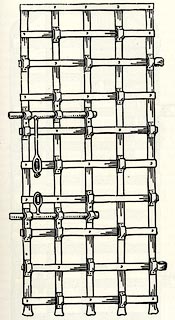 click to enlarge
click to enlargeCW0135.jpg
On p.177 of The Castles and Fortified Towers of Cumberland, Westmorland, and Lancashire North of the Sands, by John F Curwen.
printed at bottom:- "Naworth. Ld. William Howard's Tower / 6' 0" x 2' 8""
item:- Armitt Library : A782.35
Image © see bottom of page
placename:- Naworth Castle
item:- turret
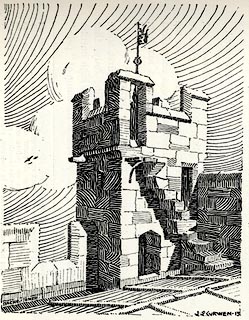 click to enlarge
click to enlargeCW0138.jpg
On p.185 of The Castles and Fortified Towers of Cumberland, Westmorland, and Lancashire North of the Sands, by John F Curwen.
printed at bottom:- "GUARD TURRET AT NAWORTH CASTLE."
printed at lower right:- "J. F. CURWEN. 13"
item:- Armitt Library : A782.38
Image © see bottom of page
placename:- Naworth Castle
item:- Dacre's Tower
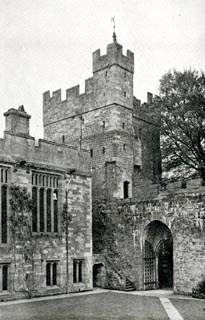 click to enlarge
click to enlargeCW0142.jpg
Tipped in opposite p.213 of The Castles and Fortified Towers of Cumberland, Westmorland, and Lancashire North of the Sands, by John F Curwen.
printed at bottom:- "NAWORTH CASTLE: DACRE'S TOWER."
item:- Armitt Library : A782.42
Image © see bottom of page
placename:- Naworth Castle
courtesy of English Heritage
"NAWORTH CASTLE / / / BRAMPTON / CARLISLE / CUMBRIA / I / 77855 / NY5599562585"
courtesy of English Heritage
"Castle and seat of the Earls of Carlisle. Probably late C13, first mentioned in 1323 (V.C.H. Cumberland p.255), licence to crenellate, 1335, granted to Ranulph de Dacre; additions c1520, for and by, Thomas Lord Dacre; further additions 1602 (date & initials W.H. on rainwater head), for Lord William Howard; Vanburgh designed music gallery and screen for 3rd Earl and may have been responsible for work on the kitchen offices; Colvin mentions work by C.H. Tatham for the 5th Earl; Salvin restored the north and east ranges after the fire of 1844. Calciferous and red dressed sandstone, lead and slate roofs, stone chimney stacks. Formerly: tower house (Dacre Tower) with south curtain wall; hall and chapel ranges with north-east angle gate tower (Lord William Howard's Tower) all altered c1520 and 1602; Morpeth Tower added to hall, 1845; C18 &C19 west and south range with Stanley Tower of 1881. East range living quarters of 2 storeys, 9 bays, has flanking 3 storey, one bay towers, with battlemented parapets to each. Small square headed mullioned windows with square leaded panes: large and small round headed mullioned windows to courtyard, have diamond leaded panes. South curtain wall has large C16 pointed arch, with recessed chamfered surround and large iron studded gates, giving access to large open courtyard; arms of Lord William Howard above. North range has external but engaged, Morpeth Tower of 2 storeys, 2 bays: hall of 2 storeys, 9 bays, has raised courtyard entrance, with carved stone panel of Dacre arms above. Square 2-light and round headed 3-light mullioned windows have diamond leaded panes. Battlemented parapet and 1982 slate roof, replacing 1845 lead (grant aided by Historic Buildings Council). West range, 3 storeys, 6 bays, is of similar details, formerly kitchens and servants'quarters, now let as flats."
"Interior has wood panelled library and other panelled rooms by C.J. Ferguson, with painted gesso overmantel panel of The Battle of Flodden by Burne-Jones and Sir E. Boehm, 1882. Hall gutted by fire 1844, but retains large C16 fireplace with segmental head: wooden hammer beam roof by Salvin 1845. Lord William Howard's tower is supported on ribbed arches crossing the angle of the north-east walls. Lord William's chamber has timber ceiling, c1350, from Kirkoswald Castle, with moulded beams and bosses and panels filled with flowing tracery. The oratory contains part of a screen from Lanercost Priory with crocketed ogee panels and a German painting dated 1514, representing the Flagellation, Crucifixion and Resurrection. Dacre Tower has ground floor iron yett."
"Transactions, Cumberland & Westmorland Antiquarian &Archaeological Society, old series, iv, p.486-509"
"Country Life, 25 March 1911, p.414-22."
courtesy of English Heritage
"WALLED GARDEN EAST OF NAWORTH CASTLE / / / BRAMPTON / CARLISLE / CUMBRIA / II / 77858 / NY5609362537"
courtesy of English Heritage
"Garden walls. Probably C18, covering site of the filled moat. Calciferous and red sandstone rubble on 3 and partly 4 sides, 2 metres high, with semicircular corner projection to south-east."
courtesy of English Heritage
"GATEHOUSE EAST OF NAWORTH CASTLE / / / BRAMPTON / CARLISLE / CUMBRIA / I / 77856 / NY5600262565"
courtesy of English Heritage
"Gatehouse. Circa 1520, for and by Thomas Lord Dacre, with additions for Lord William Howard c1602 and probably restored by Salvin 1845. Earlier dressed calciferous sandstone to ground floor and red sandstone above with battlemented parapet. 2 storeys, 2 bays. Round arched entrance has large carved stone panel of Dacre arms above, flanked by small leaded casements with chamfered surrounds: similar similar windows to rear. Built as part of the early C16 outer bailey of the castle, between the moat and east range, replacing the earlier gate in Lord William Howard's Tower. For details of arms see, Transactions, Cumberland & Westmorland Antiquarian &Archaeological Society old series. iv. p.496-7."
placename:- Naworth Castle
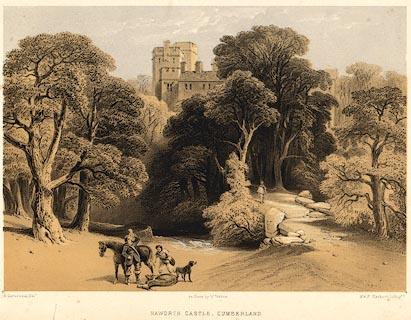 click to enlarge
click to enlargePR0425.jpg
Huntsmen with a deer in the foreground.
printed at bottom:- "G. Cattermole Delt. on Stone by W. Walton M &N Hanhart, Lithogrs. / NAWORTH CASTLE, CUMBERLAND"
item:- Dove Cottage : 2008.107.418
Image © see bottom of page
placename:- Naworth Castle
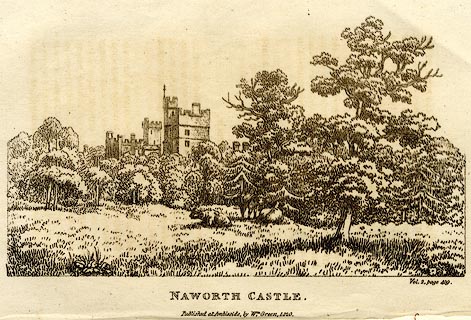 click to enlarge
click to enlargePR0418.jpg
printed at bottom right, centre:- "Vol.2 page 409. / NAWORTH CASTLE. / Published at Ambleside, by Wm. Green, 1820."
item:- Dove Cottage : 2008.107.411
Image © see bottom of page
placename:- Naworth Castle
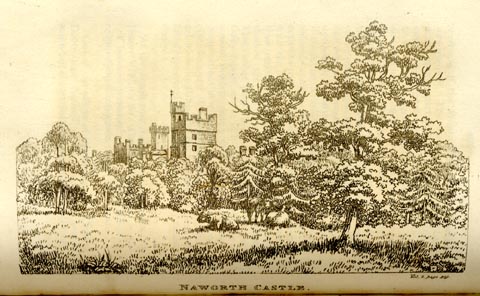 click to enlarge
click to enlargeGN0134.jpg
Tipped in opposite vol.2 p.409 of The Tourist's New Guide, by William Green.
printed at bottom right, centre:- "Vol.2, page 409. / NAWORTH CASTLE."
item:- Armitt Library : A1141.35
Image © see bottom of page
placename:- Naworth Castle
 click to enlarge
click to enlargePR0200.jpg
printed at bottom left, right, centre:- "T. Hearne F.S.A. delt. / I. Landseer Engraver to the King sculp. / Naworth Castle. / London: Published March 7, 1816 by T. Cadell &W. Davies Strand."
item:- Dove Cottage : 2008.107.200
Image © see bottom of page
placename:- Naworth Castle
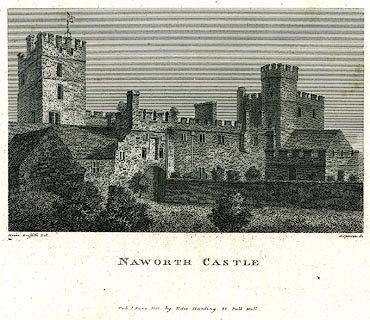 click to enlarge
click to enlargePR0226.jpg
printed at bottom left, right, centre:- "Moses Griffith Del. / S. Sparrow Sc. / NAWORTH CASTLE / Pub 1 June 1801, by Edw. Harding, 98 Pall Mall."
item:- Dove Cottage : 2008.107.226
Image © see bottom of page
placename:- Naworth Castle
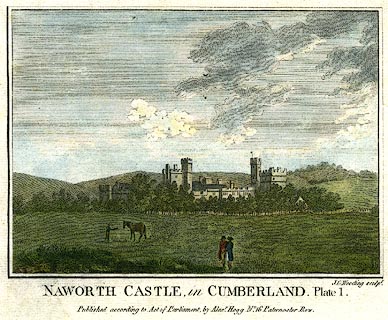 click to enlarge
click to enlargePR0227.jpg
printed at bottom right, centre:- "J. G. Wooding sculpt. / NAWORTH CASTLE in CUMBERLAND. Plate 1. / Published according to Act of Parliament, by Alexr. Hogg No.16 Paternoster Row."
item:- Dove Cottage : 2008.107.227
Image © see bottom of page
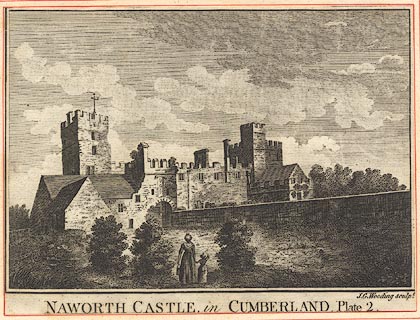 click to enlarge
click to enlargeBMZ26.jpg
item:- Dove Cottage : Lowther.79
Image © see bottom of page
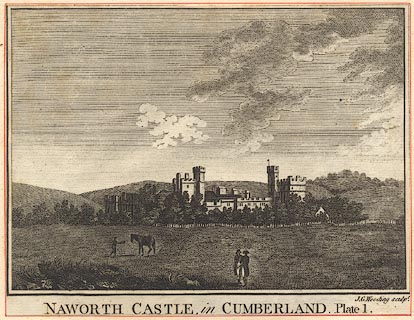 click to enlarge
click to enlargeBMZ25.jpg
item:- Dove Cottage : Lowther.78
Image © see bottom of page
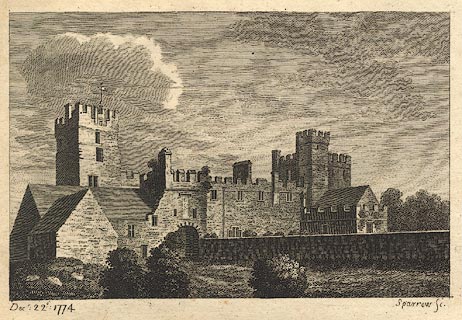 click to enlarge
click to enlargeBMZ29.jpg
item:- Dove Cottage : Lowther.82
Image © see bottom of page
placename:- Naworth Castle
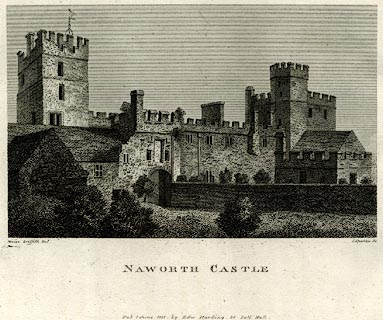 click to enlarge
click to enlargePEN624.jpg
Tipped in opposite p.173 of A Tour from Downing to Alston Moor, 1773, by Thomas Pennant.
printed at bottom left, right, centre:- "Moses Griffith. Del / S Sparrow Sc / NAWORTH CASTLE / Pub June 1 1801 by Edw Harding 98 Pall Mall."
item:- Armitt Library : A1057.24
Image © see bottom of page
placename:- Naworth Castle
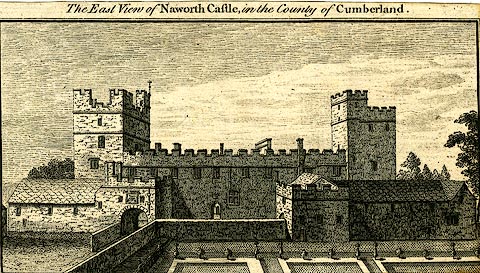 click to enlarge
click to enlargePR0187.jpg
Included in a set of castle pictures?
printed at bottom:- "The East View of Naworth Castle, in the County of Cumberland."
item:- Dove Cottage : 2008.107.187
Image © see bottom of page
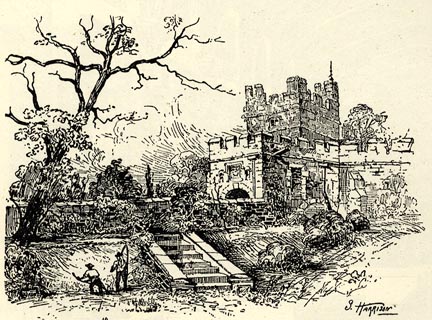 click to enlarge
click to enlargeBGG114.jpg
Included on p.54 of Lakeland and Ribblesdale, by Edmund Bogg.
item:- JandMN : 231.14
Image © see bottom of page
placename:- Naworth Castle
item:- armour
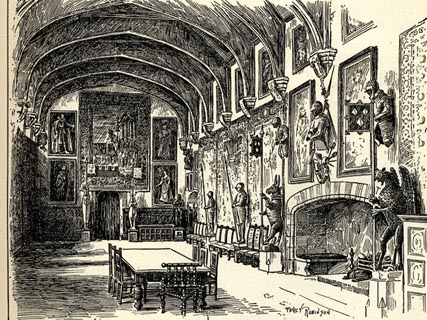 click to enlarge
click to enlargeBGG113.jpg
Included on p.53 of Lakeland and Ribblesdale, by Edmund Bogg.
item:- JandMN : 231.13
Image © see bottom of page
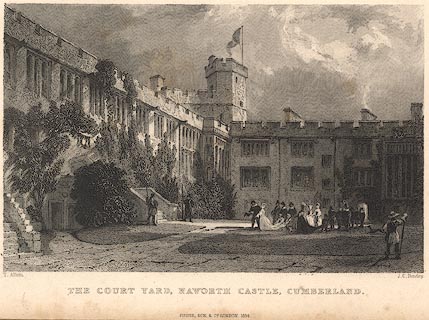 click to enlarge
click to enlargeR224.jpg
"Courtyard, Naworth Castle, Cumberland"
item:- JandMN : 96.13
Image © see bottom of page
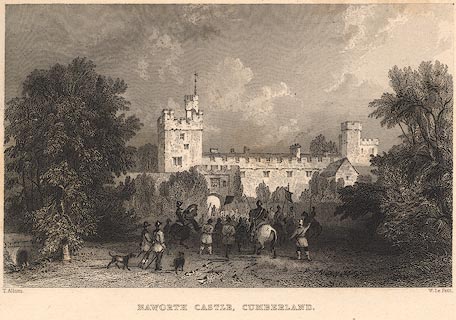 click to enlarge
click to enlargeR207.jpg
"Naworth Castle, Cumberland"
item:- JandMN : 96.4
Image © see bottom of page
item:- oratory; chapel
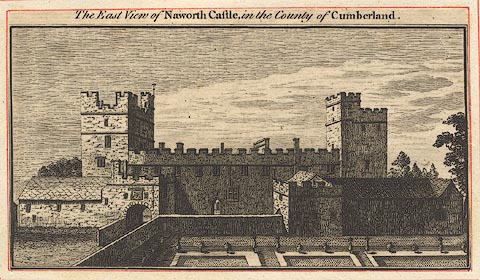 click to enlarge
click to enlargeBMZ27.jpg
"NAWORTH CASTLE, CUMBERLAND."
"PLATE I."
"THIS Castle is still entire. For the annexed account of it, and its furniture, I am indebted to Thomas Pennant, Esq. who permitted me to transcribe it from his memorandums. A visit I made to it in August, 1774, enables me to bear testimony to the faithfulness of the description, which here follows in his own words:"
"'Two miles from Brampton visit Naworth Castle, once belonging to the Dacres, afterwards the property (I think by marriage) of William Lord Howard, commonly known by the name of Bauld-Willey."
"IT is a large pile, square, and built about a court. In the south side is a gateway, with the arms of the Dacres; over the door, those of the Howards. On the north, it impends over the river Irthing, at a great height; the banks shagged with wood. The whole house is a true specimen of ancient inconvenience, of magnificence and littleness; the rooms numerous, accessible by sixteen stair-cases, with most frequent and sudden ascents and descents into the bargain. The great hall is twenty-five paces long, by nine and a half broad; of a good height; has a gallery at one end, adorned with four vast crests, carved in wood; viz. a griffin and dolphin, with the scollops; an unicorn, and an ox with a coronet round his neck. In front, is a figure in wood of an armed man; two others, perhaps vassals, in short jackets and caps; a pouch pendant behind, and the mutilated remains of a Priapus to each; one has wooden shoes. These seem to be the Ludibrium Aulae in those gross days."
"THE top and upper end of the room is painted in figures, to the number of 107, representing the Saxon kings and heroes. The chimney here is five yards and a half broad. Within this is another apartment, hung with old tapestry, a head of Anne of Cleeves; on one side of her, a small picture of a lady full-length, &c. and many others."
"A long narrow gallery."
"LORD William Howard's bed-room, arms and motto over the chimney. His library, a small room, in a very secret place, high up in one of the towers, well secured by doors, and narrow stair-case. Not a book has been added since his days, i.e. those of Queen Elizabeth. In it is a vast case, three feet high, which opens into three leaves, having six great pages pasted in, being an account of St. Joseph of Arimathea, and his twelve disciples, who founded Glastonbury; and at the end, a long history of saints, with the number of years or days for which each could grant indulgences."
"THE roof is coarsely carved. The windows are high, and are to be ascended by three stone steps; such was the caution of the times. It is said Lord William was very studious, and wrote much; that once, when he was thus employed, a servant came to tell him that a prisoner was just brought in, and desired to know what should be done with him? Lord William, vexed at being disturbed, answered peevishly, Hang him. When he had finished his study, he called, and ordered the man to be brought before him for examination; but found that his orders had been literally obeyed. He was a very severe, but most useful man at that time, in this lawless place. His dungeon instills horror; it consists of four dark apartments, three below, and one above, up a long stair-case, all well secured; in the uppermost is one ring, to which criminals were chained, and the marks where many more have been."
"CLOSE by the library is an ancient Oratory, most richly ornamented on the sides of the ceiling with coats of arms and carvings in wood, painted and gilt. On one side is a good painting on wood, in the style of Lucas Van Leyden; it represents the Flagellation of our Saviour, his Crucifixion and Resurrection. Here are also various sculptures in white marble: an abbess, with a sword in her hand; and several others. This place is well secured; for here Lord William enjoyed his religion in privacy."
"THE chapel is below stairs; the top and part of the side are painted in pannels like the hall; and on one side are the crests and arms and pedigree of the Howards, from Fulcho to 1623 and 1644. Under a great sprawling figure of an old man, with a branch rising from him (on the ceiling) is written, Pictor, MDXII. On the great window, in glass, are represented a knight and a lady kneeling; on their mantles pictured these arms, three escallops and chequers.'"
item:- Dove Cottage : Lowther.80
Image © see bottom of page
item:- roman inscription; inscription, roman
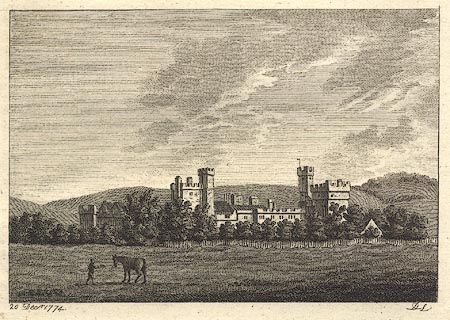 click to enlarge
click to enlargeBMZ28.jpg
"NAWORTH CASTLE, CUMBERLAND."
"PLATE II."
"TRADITION says this castle was built by the Dacres, but by which of them is not ascertained. One of these, Robert de Dacre, from a quotation in Madox's History of the Exchequer, seems to have been sheriff of Cumberland, and another, Ranulph de Dacre, 14th. of Ed. 1st, constable of the tower."
"THE first mention of this castle is in the reign of Richard 2d. when in the 18th of that reign, it appears from Madox's Baronia, that William de Dacre, son and heir of Hugh de Dacre, who was brother and heir of Ranulph de Dacre, held it, with the manor of Irchington, to which it belonged; also the manors of Burgh, near Sandes, Laysingby, and Farlham, and other lands, by the service of one entire barony, and of doing homage and fealty to the king, and of yielding to him for cornage at his exchequer at Carlile yearly, at the feast of the assumption of St. Mary, 51s. 8d. By what feofment, whether old or new, says Madox, does not appear; neither in what king's reign Ranulph de Dacre, ancestor of William here named, was feoff'd; but it is plain, some ancestor under whom Ranulph claimed, was enfeft to hold by barony."
"IT continued in the family of the Dacres, till the year 1569, when on the 17th of May, according to Stowe, 'George Lord Dacre of Greystoke, sonne and heire of Thomas Lord Dacre, being a child in yeere's, and then ward to Thomas Lord Howard, Duke of Norfolk, was by a great mischaunce slayne at Thetford, in the house of Sir Richard Falmenstone, knight, by meane of a vauting horse of wood, standing within the same house; upon which horse, as he meant to have vauted, and the pinnes at the feet being not made sure, the horse fell upon him, and bruised the brains out of his head.'"
"IN the January following, Leonard de Dacre, Esq; of Horsley, in the county of York, second son to Lord William Dacre of Gilsland, being dissatisfied with a legal decision, by which his nieces were adjudged to succeed to the estate of their brother the Lord Dacre, whose tragical death was just here related; he entered into a rebellion, with design to carry off the Queen of Scots; but being disappointed by her removal to Coventry, and having the command of 3000 men, which he been entrusted to raise for the queen's service, he seized several castles, among which were those of Greystock and Naworth; but being attacked and defeated by Lord Hunsdon, at the head of the garrison of Berwick, he fled to Flanders, where he died."
"THIS castle next came into the possession of Lord William Howard, the third son of Thomas Duke of Norfolk, in right of his wife Elizabeth, sister of George, the last Lord Dacre, beforementioned. In 1607, when Cambden visited it, it was under repair; and Bishop Gibson says, it was again repaired, and made fit for the reception of a family, by the Right Hon. Charles Howard, great grandson to the Lord William Howard beforementioned."
"I shall here transcribe another description of this castle and furniture, sent me by a gentleman who viewed it anno 1732, which though it repeats many things mentioned in the former account, yet it has also diverse circumstances worthy observation, not there taken notice of."
"'THIS is an ancient stone building; the front long, with a square tower at each angle; then you enter a court. In the noble hall, the pictures of Anglo-Saxon kings, and painted on wooden square panels, make the ceiling, and part of the wainscot at the further end of the room: they were brought from Kirk-Oswald castle when that was demolished. The chapel has a ceiling, and part of its wainscot of the same kind, being paintings of patriarchs, Jewish kings, &c. Here is also painted a genealogy of the family from Fulcho, with their arms. It has a floor of plaster of Paris, as have some other of the rooms. Some of the apartments are very large and spacious; the ceiling of one consists of small square panels of wood, black and white interchangeably; the white has two different carvings, the black is unwrought. The very little Popish chapel is above stairs; the inside work curiously carved and gilt; here are some small figures of the passion, &c. Joining to this chapel is the library, which has a good wooden roof; the books are old; there are not above one or two of the manuscripts here now. Vide Cat. Librorum M. S. Angl. & Hib. Tom 2d, p.14, &c. The Earl of Carlisle never lives here, but at Castle-Howard in Yorkshire. In the garden wall are stones with Roman inscriptions, collected probably from the Picts Wall; a general account of these stones is given in Horsley's Britannia Romana.'"
"CAMBDEN, who also mentions these stones, gives the following copy of some of their inscriptions. One is,"
"IVL. AVG. DVO. . M SILV. . VM"
"On another"
".I. O. M .... II .AEL . DAC .. C.P ... EST VRELIVS. FA. L. S. TRIB. PET. VO. COS."
"On a third,"
"LEG. II. AVG."
"On a fourth,"
"COH. J. AEL. DAC. CORD. . ALEC . PER ..."
"THESE stones were, by the late Earl of Carlisle, given to Sir Thomas Robinson, who married his sister, and were by him removed to his museum in Rooksby."
"This view, which represents the entrance to the castle, was drawn anno 1772."
item:- Dove Cottage : Lowther.81
Image © see bottom of page
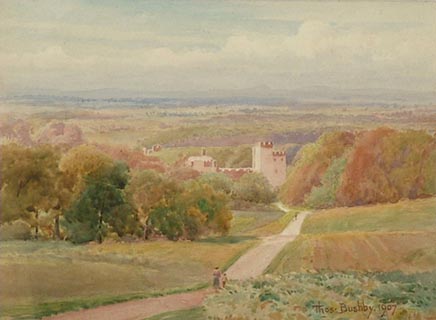 click to enlarge
click to enlargePR1353.jpg
View taken from road above Naworth Castle looking north with Naworth Castle in the middle distance and Lanercost and border hills beyond.
signed at bottom right:- "Thos: Bushby.1907"
item:- Tullie House Museum : 1999.803.3
Image © Tullie House Museum
placename:- Naworth Castle
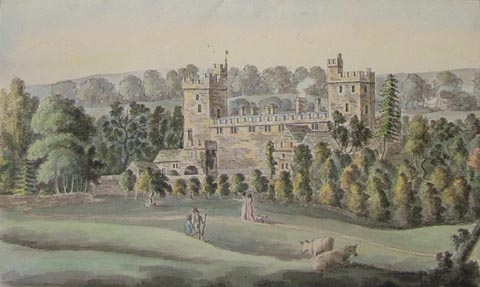 click to enlarge
click to enlargePR1239.jpg
Included in an album The Antiquities of the City of Carlisle. View of Naworth Castle from the south on the site of the curent walled garden. Two men and two women with a dog are conversing and walking in open meadow in front fo the cstle beside two cattle. Beyond the castle Walton Wood can be seen and a cottage on the far right.
inscribed at bottom centre:- "NAWORTH CASTLE in CUMBERLAND from the S.E."
signed at bottom left:- "Drawn on the spot by Robert Carlile."
item:- Tullie House Museum : 1978.108.77.12
Image © Tullie House Museum
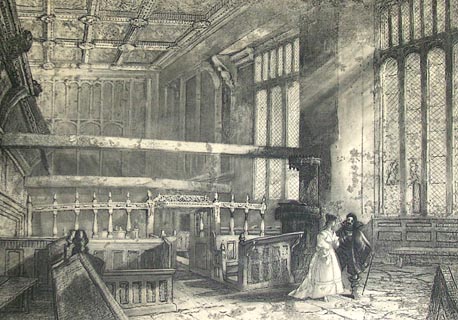 click to enlarge
click to enlargePR1261.jpg
Chapel with slanting sunlight streaming through the windows to right of composition. A couple wearing seventeenth century dress stand conversing; the chapel is otherwise deserted.
inscribed at bottom left of paper:- "NAWORTH CHAPEL"
item:- Tullie House Museum : 1978.108.89
Image © Tullie House Museum
item:- sculpture
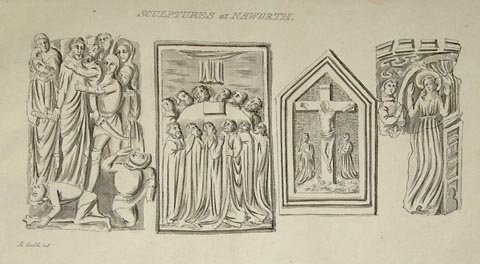 click to enlarge
click to enlargePR1251.jpg
Included in an album The Antiquities of the City of Carlisle. Drawing of four individual stone carved religious sculptures in Naworth Castle near Brampton.
inscribed at top centre:- "SCULPTURES at NAWORTH."
signed at bottom left:- "R.Carlile.del."
item:- Tullie House Museum : 1978.108.77.26
Image © Tullie House Museum
item:- sculpture
 click to enlarge
click to enlargePR1252.jpg
Included in an album The Antiquities of the City of Carlisle. Drawing of seven marble sculptures of religious figures in the oratory at Naworth Castle near Brampton.
inscribed at top centre:- "MARBLE SCULPTURES in the ORATORY at NAWORTH."
signed at bottom left:- "R.Carlile.del."
item:- Tullie House Museum : 1978.108.77.27
Image © Tullie House Museum
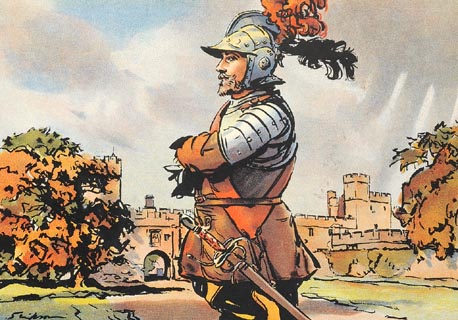 click to enlarge
click to enlargePR1430.jpg
Belted Will, Lord Wiliam Howard, stands in profile wearing armour in front of Naworth Castle, near Brampton.
signed at bottom left on print:- "Simpson"
 click to enlarge
click to enlargePR1431.jpg
text by T Gray about Belted Will at Naworth on reverse of coloured print by Joseph W Simpson, 1924.
item:- Tullie House Museum : 2009.210.9
Images © Tullie House Museum
item:- beech; tree
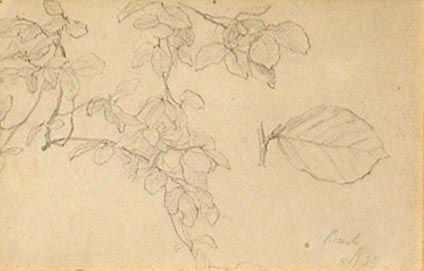 click to enlarge
click to enlargePR1157.jpg
upper - Study of the end of a slender branch with separate detailed study of a leaf to right.
central - Study of the base of a tree and its roots, standing in the midst of a wood.
lower - Study of the end of a slender branch with fainter study of a similar type beneath.
inscribed &dated at bottom right:- "Beech Naworth 80"
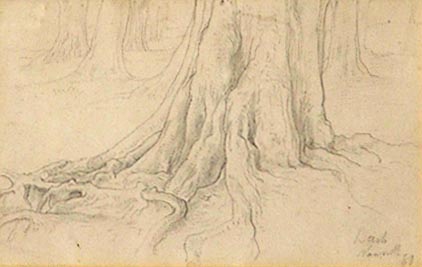 click to enlarge
click to enlargePR1158.jpg
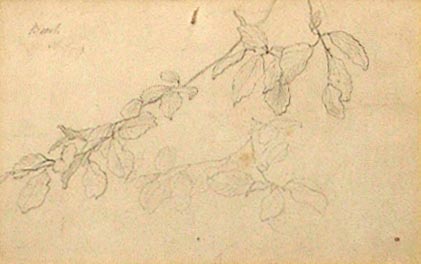 click to enlarge
click to enlargePR1159.jpg
item:- Tullie House Museum : 1975.52
Images © Tullie House Museum
item:- armour; cradle; saddle; gloves
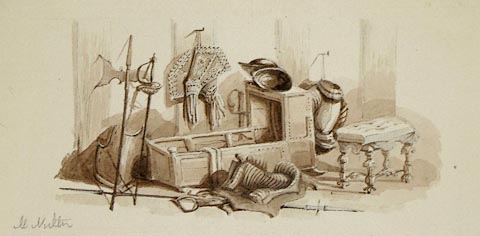 click to enlarge
click to enlargePR1084.jpg
A collection of seventeenth century objects. To left, a breastplate, halberd and sword lean against the panelled wall beside a cradle above which a pair of elaborately decorated gloves are suspended from a nail. A helmet lies on the cradle's hood. A pike and a saddle lie in front of it and to the right of the composition a padded stool stands in front of a further piece of armour hanging from a nail driven into the wall.
signed at bottom left:- "M Nutter"
inscribed at bottom centre:- "Lord Will. Howard's Cradle, Gloves, Saddle etc. Scene in the Gallery"
item:- Tullie House Museum : 1970.80.10
Image © Tullie House Museum
item:- armour; sword
 click to enlarge
click to enlargePR1085.jpg
Stone passageway with boarded floor and mullioned window to right; a sword and breastplate lean against the left hand wall. At the far end of the gallery stands an heavy door with iron ribs, ajar.
signed at bottom left:- "M Nutter"
inscribed at bottom centre:- "outside of the Strong Door leading to Lord Wilm Howards Sleeping Room etc etc. from the Gallery"
inscribed at bottom right:- "Door oak with Iron ribs and bolts"
item:- Tullie House Museum : 1970.80.11
Image © Tullie House Museum
item:- bed; fireplace; four poster bed
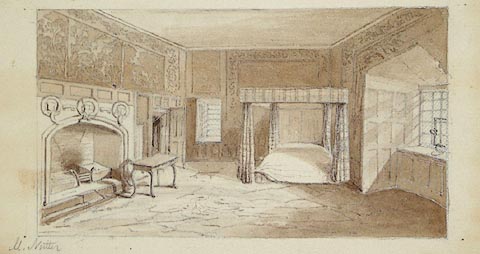 click to enlarge
click to enlargePR1086.jpg
Sparsely furnished room with a fourposter bed standing in far right corner, a recessed casement window to its left. Larger window in an alcove to extreme right of composition; fireplace to left with a stool standing in front of it. The upper portion of the walls, above the panelling, is hung with tapestry.
signed at bottom left:- "M Nutter"
inscribed at bottom centre:- "Lord Willm Howards Bed Room"
item:- Tullie House Museum : 1970.80.12
Image © Tullie House Museum
item:- door; stair
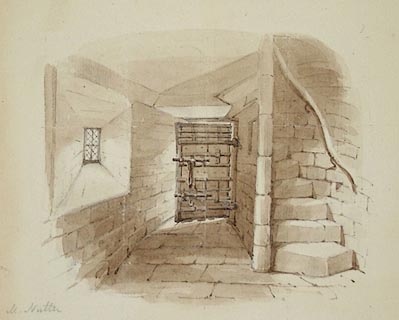 click to enlarge
click to enlargePR1087.jpg
signed at bottom left:- "M Nutter"
item:- Tullie House Museum : 1970.80.13
Image © Tullie House Museum
placename:- Naworth Castle
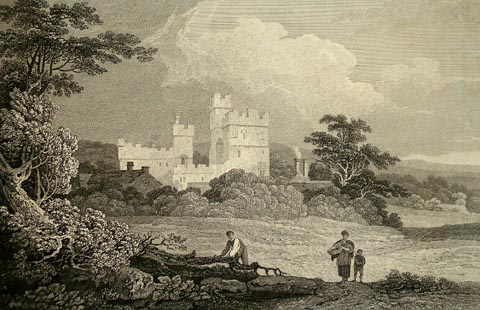 click to enlarge
click to enlargePR1185.jpg
View of Naworth Castle in summertime. In the foreground stand three figures; a man cutting wood, a woman cayrying a basket, and a child accompanying her. In the middle distance stand the castle and its outbuildings; distant hills rise beyond.
inscribed at bottom left on print:- "Drawn by P.S. Munn"
printed at bottom centre:- "NAWORTH CASTLE"
inscribed at bottom right on print:- "Engraved by S. Middiman"
item:- Tullie House Museum : 1976.169.2.27
Image © Tullie House Museum
 click to enlarge
click to enlargePR1025.jpg
Autumn; corner of the courtyard of Naworth Castle with stairs to main entrance to right. Creeper covers the wall of the hall.
item:- Tullie House Museum : 1969.33
Image © Tullie House Museum
placename:- Naworth Castle
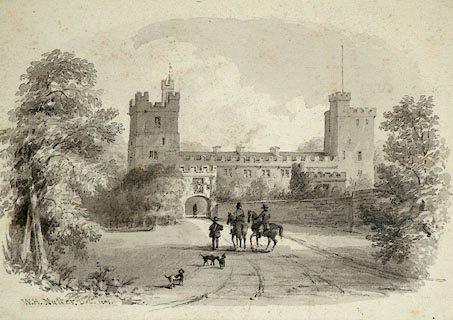 click to enlarge
click to enlargePR1036.jpg
Summertime; view of the avenue approaching Naworth Castle with three figures, two of them mounted, returning from the hunt with their dogs. A fourth figure stands in the archway of the gatehouse.
signed & inscribed &dated at bottom left:- "W.H.Nutter.Del.1841"
inscribed at bottom right on mount:- "Naworth Castle Cumberland"
item:- Tullie House Museum : 1970.33.17
Image © Tullie House Museum
placename:- Naworth Castle
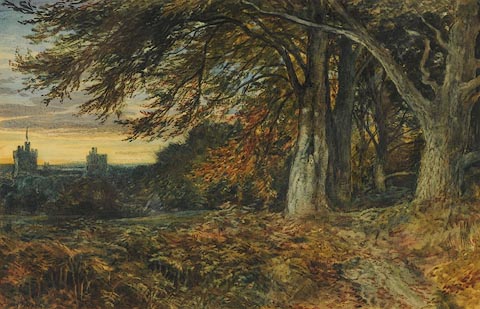 click to enlarge
click to enlargePR0985.jpg
Autumnal landscape; distant view of Naworth Castle seen from an elevated perspective at the summit of a wooded hill. The castle stands in silhouette to left of composition, the fading light of sunset glowing behind it.
item:- Tullie House Museum : 1963.43
Image © Tullie House Museum
placename:- Naworth Castle
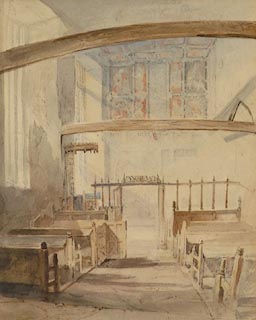 click to enlarge
click to enlargePR0955.jpg
Empty chapel with slanting sunlight streaming through the windows to left of composition.
signed at bottom left:- "TM Richardson Senr"
inscribed at bottom right:- "Belted Will Howard's Chapel, Naworth Castle"
item:- Tullie House Museum : 1947.37
Image © Tullie House Museum
placename:- Naworth Castle
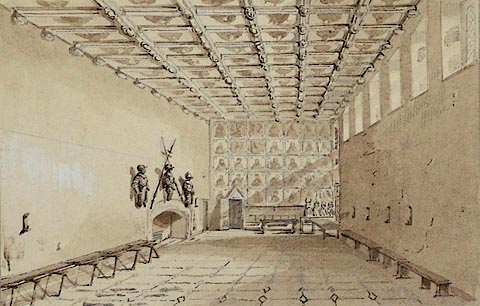 click to enlarge
click to enlargePR1082.jpg
Stone flagged hall empty except for three partial suits of armour suspended above the fireplace to left of composition and benches ranged along both side walls. To right, six windows placed high in the wall. Elaborately carved and painted ceiling and painted wall at the far end of the hall. Looking east.
Before the fire of 1844.
signed at bottom left:- "M Nutter"
inscribed at bottom centre:- "Entrance Hall Naworth Castle"
item:- Tullie House Museum : 1970.80.8
Image © Tullie House Museum
placename:- Naworth Castle
item:- armour
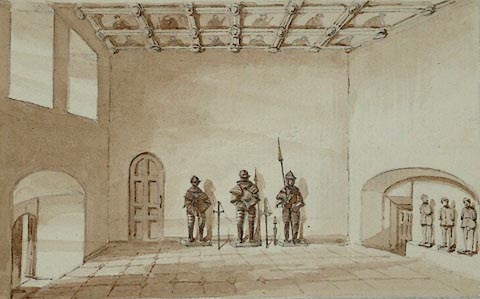 click to enlarge
click to enlargePR1083.jpg
Stone flagged hall empty except for three suits of armour standing at the far end and three small figures standing beneath a round headed arch to right of composition. To left, a doorway with two windows above it. Elaborately carved and painted ceiling.
Before the fire of 1844.
signed at bottom left:- "M Nutter"
inscribed at bottom centre:- "West end of the Entrance Hall. Naworth Castle"
item:- Tullie House Museum : 1970.80.9
Image © Tullie House Museum
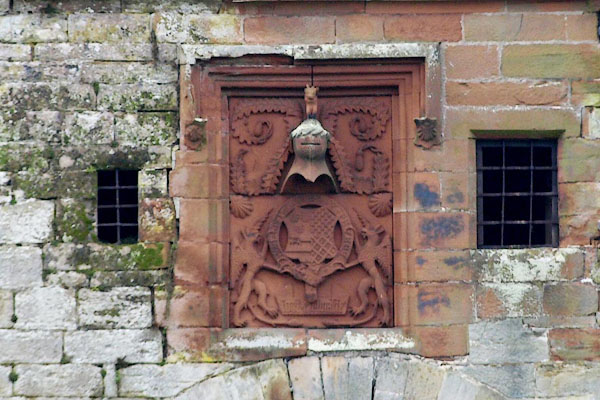
BPX52.jpg Coat of arms on the entrance arch.
(taken 16.1.2009)
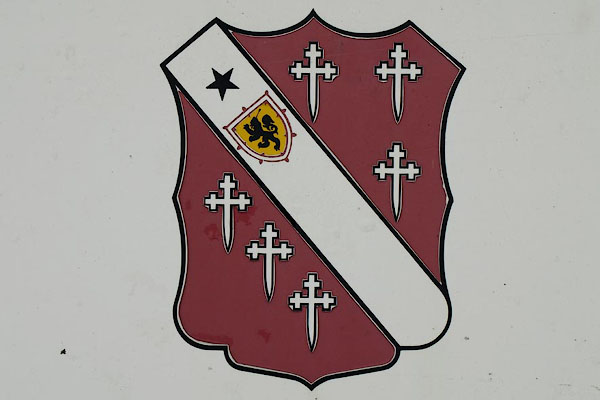
BPX53.jpg Coat of arms of the Howard Family, on a signboard by the gate.
(taken 16.1.2009)
